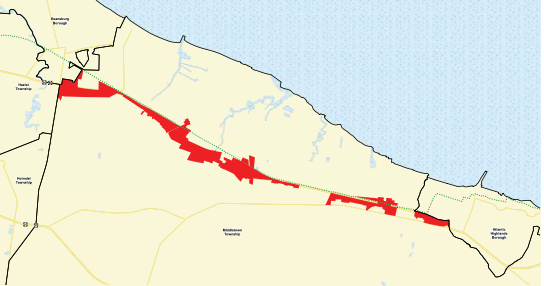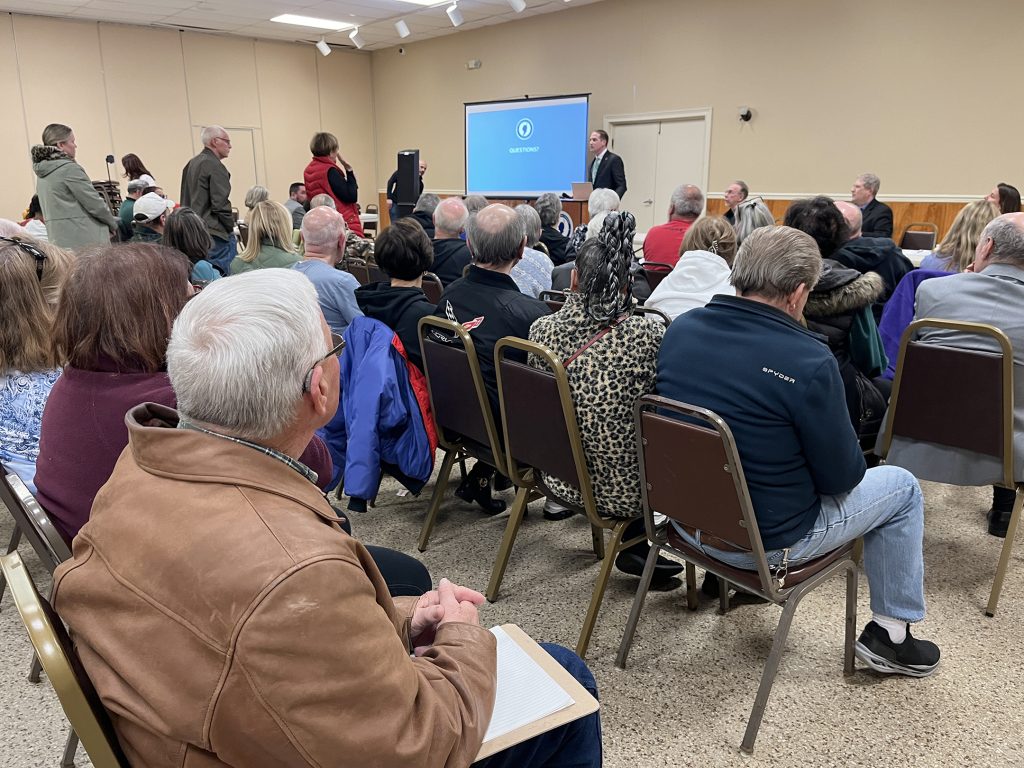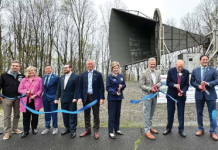
By Sunayana Prabhu
MIDDLETOWN – The township’s ambitious plan to revive the history and economic vitality of Route 36 has gained momentum. More than a hundred residents and business owners participated in the first community meeting organized by township officials to discuss redevelopment of Middletown’s section of the state corridor.
The meeting room at Port Monmouth’s VFW Post 2179 was near capacity March 16 as Mayor Tony Perry responded to both ideas and concerns from residents and business owners.
The governing body undertook a preliminary investigation to determine if this area of Route 36 fits the criteria of an area in need of redevelopment. The township has engaged the services of T&M Associates to work with the planning board on the redevelopment investigation study.
Following the initial study, the planning board identified properties along Route 36 that could be designated areas in need of development but has not made a final recommendation yet.
According to Perry, each parcel along Route 36 was evaluated but “was not placed in a redevelopment zone,” because the township is still awaiting a final report from Stan Slachetka of T&M Associates. The final report will include only certain properties that fit the redevelopment criteria specified by law.
Perry told residents there are “no plans” for any properties yet, clarifying several times during the meeting that the current redevelopment plan “does not allow eminent domain.”

Eminent domain, according to the National Association of Realtors website, is the process by which the “government may seize private property with proper compensation without the owner’s consent.” The Fifth Amendment to the Constitution stipulates that the property must be claimed for “public use” and that “just compensation” must be provided to the property owner.
In his PowerPoint presentation, Slachetka specified the redevelopment criteria and process governed by the Local Redevelopment & Housing Law. Public or privately owned properties deemed “substandard,” “abandoned” or “vacant” for over 10 years; “dilapidated” structures; areas impacted by natural disasters; and others qualify for redevelopment.
However, Slachetka said not all properties will qualify for redevelopment, explaining there are six stages in designating an area for redevelopment. The next steps include the planning board forwarding their formal recommendations to the governing body regarding properties that meet the redevelopment criteria and the township adopting a redevelopment plan and entering into a contract with a redeveloper or owner for each property. Then the planning board would review the project to decide if it is consistent with the redevelopment plan. If the governing body agrees with the planning board’s recommendation, it would adopt a resolution designating the area in need of redevelopment which would be sent to the Commissioner of the New Jersey Department of Community Affairs for approval.
The township has divided the entire stretch of Route 36 under study from Keansburg to Atlantic Highlands into three sections: Section A covers Palmer Avenue to Main Street; Section B covers Main Street to East Road; and Section C runs from Broadway Avenue to Chamone Avenue.
A vision to spur economic growth and architectural continuity along this corridor has been a consistent theme in the township for years. Middletown has been mulling over the transformation of residential and commercial properties – several which are underutilized and vacant – spanning the nearly 5-mile stretch of roadway since December 2016.
Located close to the Sandy Hook Bayshore, Route 36 runs along beachfronts, protected wetlands and waterways like Pews and Compton creeks.
In the last few years, Perry noted, the township has accumulated over 16 acres of open space along the route “that will be preserved forever.”
While the stretch has often been viewed as “too narrow” or “too shallow” for businesses to be successful, Perry admitted the zoning has been restrictive, too. The township is working to incentivize companies by making the “zoning better” to urge development, he said.
Neighboring towns have had similar struggles creating economically viable offerings on Route 36, with the downtown business districts of some, like Atlantic Highlands and Highlands, branching out to the state roadway. But if the redevelopment plans of Middletown work, that could have a beneficial “domino effect” on neighboring municipalities, Perry said.
During the two-hour public exchange of ideas, some residents shared the governing body’s determination to revive the corridor, but several others were concerned about the impact of the whole process on their properties.
There was a majority consensus to demolish the former Wild Scallion restaurant’s “god-awful building,” said Perry. The business has been closed for over 15 years and many called the structure an “eyesore.”
While all residents want a thriving Route 36, they unanimously rejected the idea of townhomes, national retailers with “big box stores” or auto dealers along the corridor. Perry assured residents there would be no “banks,” “pizza places” or self-storage facilities, referring to the township’s efforts last year to secure a parcel from the Monmouth Conservation Foundation it was looking to sell to a self-storage developer.
“We’re all losing 15% of our property,” Young said about his neighbors between Crompton Creek and Wilson Avenue along Route 36.
However, some residents complained about losing their properties to redevelopment projects. Stuart Young, a Port Monmouth resident said he is already being impacted by the development of the Port Monmouth flood control wall.
“It’s just going to make me an island surrounded by water the next Hurricane Sandy,” he said. While Young said he is not against the redevelopment of Route 36, “don’t discount the fact that this flood control project is reducing the salability to developers” due to loss of square footage.
But Perry argued “the redevelopment plan is the best thing to mitigate the impact of the seawall” on these properties.
“If we don’t do any redevelopment plan, that situation still exists,” said township administrator Anthony Mercantante. The redevelopment standards will “allow us to make up for the fact that the easement now goes through your property.”
One business owner in Leonardo was eager for the revival of the roadway. “Since I’ve been a child this whole highway has been 90% dilapidated buildings, eyesores,” she said, asking if township officials were confident of a 10-year timeline for accomplishing the project.
Urging community participation, Perry said that, since the initial framework is done, he was “99% confident” in reviving Route 36.
The entire presentation is available on Middletown Township’s website.
The article originally appeared in the March 23 – 29, 2023 print edition of The Two River Times.














